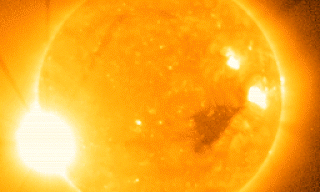Michael Ricciardi
Planet Save
Stretching for more than 100,000 km (62, ooo miles) from end to end, solar Active Region (AR) 1302 is slowly coming into position where it directly faces the Earth. The region contains a “behemoth” sunspot — several times larger than the Earth — named sunspot 1302.
The sunspot has already been the source of two ‘X-class’ solar flares (‘X’ signifying the most extreme, or largest); the first, measuring an X1.4, on September 22, and the second, an X1.9, coming just two days later on Sept. 24.
The “extreme ultra-violet flash” was captured by NASA’s Solar Dynamics Observatory (SDO).
SDO also captured a dark, shock wave racing away from the flare site. Astrophysicists believe it to be a sign that a coronal mass ejection (CME) had also occurred (see video below).
The AR has also seen several lower magnitude flares since the X1.9 blast, with M8.6 and M7.4 flares erupting on Sept. 24, and a second M8.8 flare early on Sept. 25.
None of the flares has been aimed at the Earth, but as the the Suns rotates the AR will orient itself more directly in-line with Earth. Will we be the “target” of one or more large flares? That of course is the question. AR 1302 remains active as it slowly turns towards us. Scientists are, so far, not making any guesses.
Predicting solar flares and CMEs is exceedingly difficult.
Recently, great progress was made on predicting the appearance of sunspots (which typically precede a flare) based upon the detection of acoustic wave patterns emanating from the solar interior (see my earlier article on this discovery). This new technique allows detection in as little as 24 hours in advance for some types of sunspots.
The presence of a sunspot does not guarantee a solar flare eruption (which does not, it turn, guarantee a CME), but they are related somehow. Perhaps soon, the method will be refined enough to determine which acoustic wave patterns indicate both a sunspot and a solar flare coupling.
VIDEO Below: Active Region 1302 unleashes an X1.9-category solar flare at 5:40 am EDT on Sept. 24, 2011. NASA’s Solar Dynamics Observatory (SDO) recorded the extreme ultraviolet flash in composite wavelengths (211, 193, 171 angstrom). Across the top is a graph of the x-ray intensity during the flare as recorded by the GOES spacecraft. Note: The sun has been rotated 90 degrees clock-wise.
Solar flares and the CME’s that often follow them are the main contributors to what’s known as the solar wind, a continuous flow of high-energy, sub-atomic particles. This wind is what determines most of our local “space weather” and, during active solar periods, can make space dangerous for astronauts, communication satellites, and power grids down here on the planet’s surface.
As to the long-term impact of increased solar flare activity on the Earth’s climate, this is a big unknown, and the subject of some study, and much speculation.
Sunspots are the dark spots, often in pairs of oppositely electric charge, that emerge from the sun’s interior with quasi-regular frequency, speckling the face of the sun. They are the loci of magnetically active regions caused by the blocking of convecting plasma fields from deep in the sun’s interior. As a result, the surface temperature of the ‘spot’ is actually cooler than the surrounding surface topology, an so appears darker.
linkwithin_text=’Related Articles:’



Be the first to comment on "Giant Sun Spot Turns Toward Earth – More Large Flares Possible (VIDEO)"